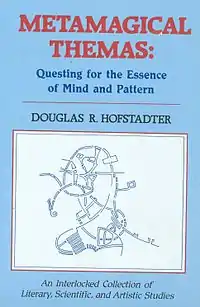 Cover of the first edition | |
| Author | Douglas Hofstadter |
|---|---|
| Country | United States |
| Language | English |
| Subjects | Frederic Chopin, free will, Heisenberg principle, Innumeracy, Lisp, memes, Prisoner's dilemma, quantum mechanics, Rubik's Cube, William Safire, strange attractors, Alan Turing, et al. |
| Published | 1985 |
| Publisher | Basic Books |
| Media type | |
| Pages | 852 |
| ISBN | 0-465-04566-9 |
| OCLC | 11475807 |
Metamagical Themas is an eclectic collection of articles that Douglas Hofstadter wrote for the popular science magazine Scientific American during the early 1980s. The anthology was published in 1985 by Basic Books.
The volume is substantial in size and contains extensive notes concerning responses to the articles and other information relevant to their content. (One of the notes—page 65—suggested memetics for the study of memes.)
Major themes include: self-reference in memes, language, art and logic; discussions of philosophical issues important in cognitive science/AI; analogies and what makes something similar to something else (specifically what makes, for example, an uppercase letter 'A' recognizable as such); and lengthy discussions of the work of Robert Axelrod on the prisoner's dilemma, as well as the idea of superrationality.
The concept of superrationality, and its relevance to the Cold War, environmental issues and such, is accompanied by notes on experiments conducted by the author at the time. Another notable feature is the inclusion of two dialogues in the style of those appearing in Gödel, Escher, Bach. Ambigrams are mentioned.
There are three articles centered on the Lisp programming language, in which Hofstadter first details the language itself, and then shows how it relates to Gödel's incompleteness theorem. Two articles are devoted to Rubik's Cube and similar puzzles. Many chapters open with an illustration of an extremely abstract alphabet, yet one which is still gestaltly recognizable as such.
The game of Nomic was first introduced to the public in this column, in June 1982, when excerpts from a book (still unpublished at the time) by the game's creator Peter Suber were printed and discussed.
The index of the book mentions Hofstadter's recurring alter ego, Egbert B. Gebstadter.
List of Hofstadter's "Metamagical Themas" columns
From January 1957 through December 1980, Martin Gardner's "Mathematical Games" column was a monthly feature in Scientific American magazine. In 1981, Gardner's column alternated with a new column by Hofstadter called "Metamagical Themas" (an anagram of "Mathematical Games"). Then Hofstadter's column appeared monthly from January 1982 through July 1983.[1]
| Date | Title |
|---|---|
| 1981 Jan. | An anagrammatic title introduces a new contributor to this column |
| 1981 March | The Magic Cube's cubies are twiddled by cubists and solved by cubemeisters |
| 1981 May | A coffeehouse conversation on the Turing test to determine if a machine can think |
| 1981 July | Pitfalls of the uncertainty principle and paradoxes of quantum mechanics |
| 1981 Sept. | How might analogy, the core of human thinking, be understood by computers? |
| 1981 Nov. | Strange attractors: mathematical patterns delicately poised between order and chaos |
| 1982 Jan. | A self-referential column about last January's column about self-reference |
| 1982 Feb. | About two kinds of inquiry: "National Enquirer" and "The Skeptical Inquirer" |
| 1982 March | Is the genetic code an arbitrary one, or would another code work as well? |
| 1982 April | The music of Frédéric Chopin: startling aural patterns that also startle the eye |
| 1982 May | Number numbness, or why innumeracy may be just as dangerous as illiteracy |
| 1982 June | About Nomic: a heroic game that explores the reflexivity of the law |
| 1982 July | Beyond Rubik's Cube: spheres, pyramids, dodecahedrons and God knows what else |
| 1982 Aug. | Undercut, Flaunt, Hruska, behavioral evolution and other games of strategy |
| 1982 Sept. | Can inspiration be mechanized? |
| 1982 Oct | Variations on a theme as the essence of imagination |
| 1982 Nov. | "Default assumptions" and their effects on writing and thinking |
| 1982 Dec. | Sense makes more sense than nonsense, but nonsense may still have its purposes |
| 1983 Jan. | Virus-like sentences and self-replicating structures |
| 1983 Feb. | The pleasures of Lisp: the chosen language of artificial intelligence |
| 1983 March | Tripping the light recursive in Lisp, the language of artificial intelligence |
| 1983 April | In which a discourse on the language Lisp concludes with a gargantuan Italian feast |
| 1983 May | Computer tournaments of the Prisoner's Dilemma suggest how cooperation evolves |
| 1983 June | The calculus of cooperation is tested through a lottery |
| 1983 July | Parquet deformations: patterns of tiles that shift gradually in one dimension |
French edition
Metamagical Themas was also published in French, under the title Ma Thémagie (InterEditions, 1988), the translators being Jean-Baptiste Berthelin, Jean-Luc Bonnetain, and Lise Rosenbaum.
The wordplay was lost in the French title, and replaced with another one (ma Thémagie would translate to "my themagy", where "themagy" is a neologism, but could also be read as maths et magie, which translates to "maths and magic"). The translators had contemplated Le matin des métamagiciens, which would have been a play on Hofstadter's title plus Le Matin des Magiciens and Jeux malins des mathématiciens (respectively, The Dawn of the Magicians and Clever Tricks of Mathematicians); however, the publisher found that suggestion to be too elaborate.
Reception
Dave Langford reviewed Metamagical Themas for White Dwarf #88, and stated that "a heady mixture of computers, art, mathematics, philosophy, jokes and above all games."[2]
References
- ↑ ""Stories by Douglas R. Hofstadter". Scientific American.
- ↑ Langford, Dave (April 1987). "Critical Mass". White Dwarf. No. 88. Games Workshop. p. 8.
External links
- Metamagical Themas at Google Books
- "A Person Paper on Purity in Language", one of the included essays, first published in September 1983
